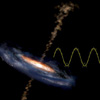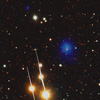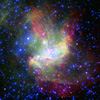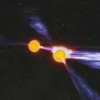2000 publications: another milestone for XMM-Newton
17 February 2009
The XMM-Newton mission passes another milestone this month with the publication of its 2000th scientific paper in peer-reviewed scientific journals. This is another indication that the mission continues to be one of the world's foremost astronomical observatories.XMM-Newton - a pre-eminent astronomical observatory
 |
Addressing a diverse array of objects and topics
Among the astronomical objects covered in the 2000-plus papers have been comets and planets, quasars and clusters of galaxies, neutron stars and black holes, as well as diffuse X-ray emission from the cosmic background and interstellar regions.
Among the recent scientific highlights are:
|
The unambiguous detection of quasi-periodic oscillation in a supermassive black hole, |
 |
 |
Discovery of 2XMM J083026+524133, the most massive cluster of galaxies known in the Universe – the high effective area of XMM-Newton makes it particularly suited to detecting extended objects such as these galaxy clusters |
|
Detection of a 2.6 s oscillation from the magnetar SGR 1627-41, providing another key insight into this rare and unusual class of stellar object |
 |
 |
X-ray observations of NGC 346 which, as part of a multi-wavelength analysis, provided an important key in unravelling the star-formation mechanism at play within this region of the Small Magellanic Cloud |
|
The unravelling of complex behaviour in the double pulsar PSR J0737-3039 – pulsars are a natural laboratory for the study of high-energy interaction processes and yield information not only on astrophysical process such as the physics of the interacting pulsars winds or magnetospheres of neutron stars, but also on more general physical questions relating to the equation of state of super-dense matter and to magneto-hydrodynamics |
 |
User support is crucial – the role of the SOC is key
Scientists using XMM-Newton can depend on a well-established user support community based at the XMM-Newton Science Operations Centre (SOC), at ESAC, near Madrid, Spain.
The range of support is extensive and covers all aspects needed by the scientific community to exploit the capabilities of the spacecraft.
Any scientists wishing to request observing time with XMM-Newton can rely on the assistance of the SOC in the preparation of the request and in the optimisation of their successful proposals. Once the observation has been made the SOC will ensure that the data is calibrated and distributed in a timely manner. Analysis of the data is facilitated by use of the Science Analysis System (SAS) software which has been specifically developed for analysing XMM-Newton data. The SOC plays an active role in contributing to the development and maintenance of the SAS.
The SOC is also responsible for the long-term planning of the spacecraft activities - covering one year of observations - and for the detailed short-term planning - prepared a few weeks in advance of the actual observations. The short term planning must occasionally account for unexpected events, such as Targets of Opportunity (TOO). For some TOOs which require a rapid reaction a turnaround time of a few hours from alert to observation can be achieved with re-planning by the SOC.
Requests from the scientific community for a TOO are addressed to the SOC who are responsible for implementing those approved by the project scientist.
Additional services include maintaining a help desk service, updating mission information (presented as web pages or as documentation), monitoring the health and performance of the instruments and updating the calibration of the instruments.
Scientific workshops are regularly organised by the SOC with the purpose of fostering the science return of the mission by providing a forum for presenting and discussing new results. In addition, a series of SAS workshops are held regularly at ESAC, aimed at providing XMM-Newton users with intensive, hands-on tutorials to enable them to successfully reduce and analyse XMM-Newton data.
Public archives contain a wealth of data
Once the proprietary period of one year has passed the data is made public via the XMM-Newton Science Archive hosted at ESAC. In addition to XMM-Newton scientific data products and observation-related information, a number of high-level catalogues or multi-wavelength datasets are available: the 2XMMi Serendipitous EPIC Source Catalogue, the XMM-OM Serendipitous Ultra-violet Source Survey Catalogue, the Slew Survey EPIC Source Catalogue, and images from the X-ray follow-up & Identification (XID) programme. Each month more than 100 scientists access the archive downloading between 1000 and 4000 data sets for further scientific analysis.
A bright future for XMM-Newton
As it heads towards the completion of a decade of operations XMM-Newton's unique combination of high throughput X-ray imaging and spectroscopy, and broad band (optical and UV) capabilities, together with the excellent health of the spacecraft and instruments ensure a bright future for this flagship observatory.
Contact details
Norbert Schartel, ESA XMM-Newton Project Scientist
Email: Norbert.Schartel esa.int
esa.int
María Santos-Lleo, ESA XMM-Newton Science Support Manager
Email: Maria.Santos-LLeo esa.int
esa.int
